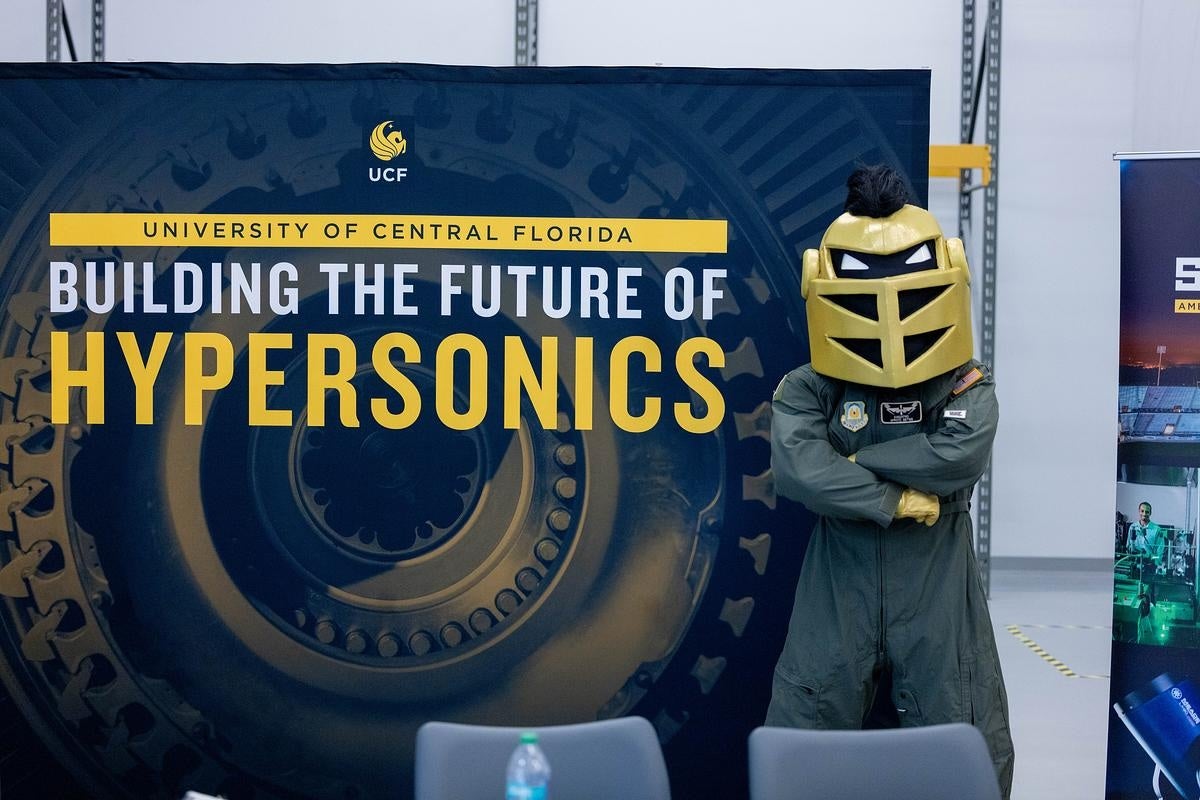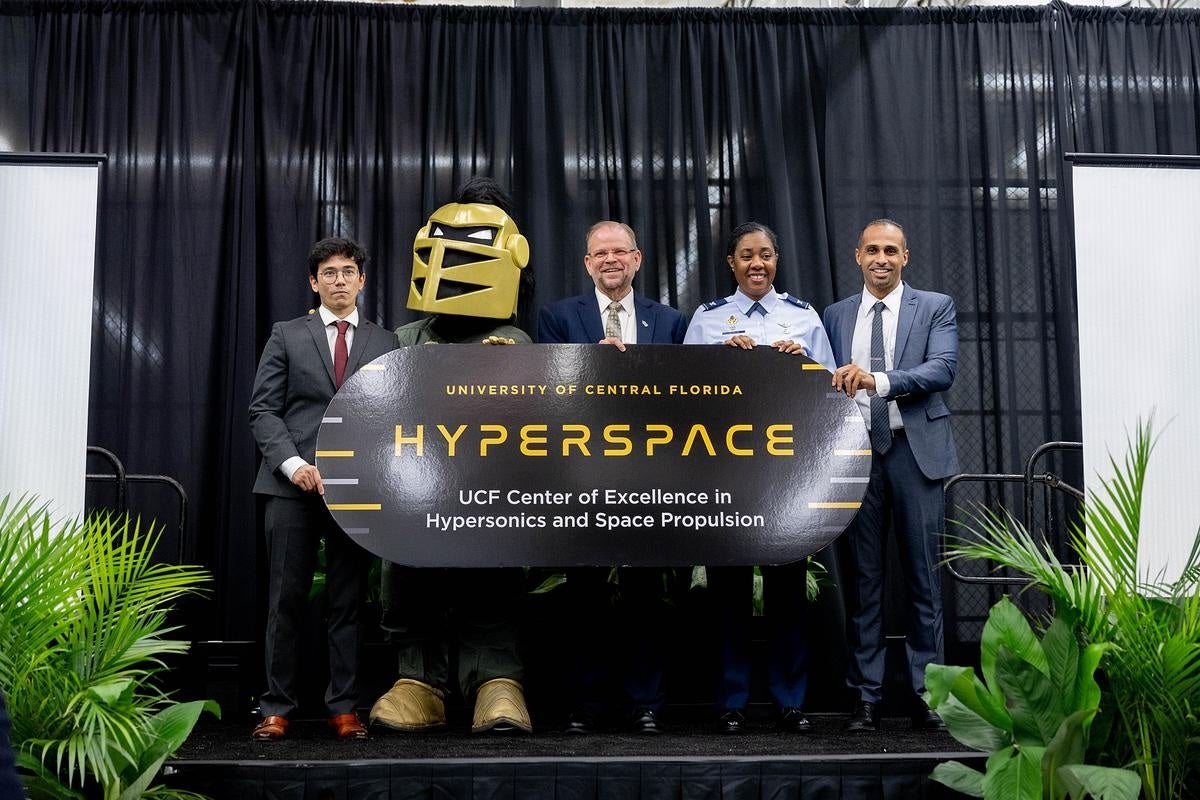A new UCF center of excellence will aim to advance the technology that fuels hypersonic travel — at speeds up to 13,000 miles per hour — to help enhance national defense and open up new frontiers in space exploration.
UCF launched the Center of Excellence in Hypersonic and Space Propulsion — HyperSpace Center for short — on Wednesday alongside leaders of the U.S. Air Force Office of Scientific Research, one of the university’s main partners in hypersonic research.
The HyperSpace Center will advance the research and innovations of world-renowned faculty members like Kareem Ahmed, a professor of mechanical and aerospace engineering in the College of Engineering and Computer Science, whose team has received multiple U.S. Department of Defense (DoD) grants to develop hypersonic technology.
“What we create here and across UCF will define the aerospace and defense industries for generations.” — Alexander N. Cartwright, UCF president
UCF President Alexander N. Cartwright and Col. Janelle T.H. Jackson, deputy director of the Air Force Office of Scientific Research and detachment 14 commander, spoke at the launch ceremony at the new center in the Central Florida Research Park adjacent to the UCF main campus. They were joined by U.S. Reps. Darren Soto and Daniel Webster and State Rep. Susan Plasencia.
“What we create here and across UCF will define the aerospace and defense industries for generations,” Cartwright says. “UCF has always been an institution for people who have dared to invent a better future. We are also an institution that recognizes no one builds the future alone.
It takes strong partnerships, shared vision, and a relentless commitment to be bold together. UCF and the Air Force have an incredible history of collaboration, and I am excited about our dedication to continuing to build, innovate, and lead together.”
Col. Jackson celebrated the significance of the HyperSpace Center bringing together the DoD, UCF as a minority-serving institution and cutting-edge technology.
“Today, the University of Central Florida is not only opening a new, top-notch facility where leading-edge research in hypersonics and space propulsion will take place,” Col. Jackson says. “You are also opening doors and opportunities to students from various backgrounds.”
“They are gaining the opportunity to realize their dreams, to work towards expanding the scientific frontier and disciplines that are of great importance to the Department of Defense and also to the larger DoD ecosystem. The hyperspace hub is a place where these students can become the thought leaders and problem solvers of tomorrow.”

Ahmed’s research team includes 40 graduate students and 25 undergraduates. The team’s research will transition from other labs on campus into the new facility and will benefit from a unique and upgraded testing environment for hypersonic materials, aerodynamics and propulsion. The Air Force Office of Scientific Research has supported Ahmed’s team through multiple research grants.
Hypersonic propulsion allows for air travel at speeds of Mach 6 to 17, meaning six to 17 times the speed of sound, or more than 4,600 to 13,000 mph.
Advanced hypersonic propulsion systems are a national priority and are essential to maintaining U.S. national defense as global technological advancements continue to evolve. High-speed propulsion research requires hypersonic facilities that can generate the representative flight Mach numbers.
For space travel, hypersonic technology holds promise for opening up the boundaries of space exploration as it fuels flights through the Earth’s atmosphere at very high speeds and allows for safe and efficient entries and exits through planetary atmospheres.
On Earth, flying at hypersonic speeds means going from New York to London in less than 15 minutes — making it much more convenient to travel to close an important business deal, attend a best friend’s wedding or see a bucket-list sporting event.
Ahmed’s research holds promise in all of those areas — and also is preparing students on his team to be innovators and leaders in the field after they graduate, demonstrating why UCF is both Florida’s premier engineering and technology university, and the nation’s No. 1 supplier of graduates to the aerospace and defense industry for six years in a row, according to Aviation Week Network.
“It’s important that UCF lead this research, primarily because of the student talent that we have,” Ahmed says. “Industry is interested in our top talent. Once they graduate, they are already hired by industry, pretrained on the topics they would explore and they become the next generation of leaders in this technology.”
The DoD is providing more than $20 million in funding to support Ahmed’s research, including for developing the first hypersonic rotating detonation rocket engine and creating a morphing hypersonic engine.
UCF’s longstanding partnership with the U.S. Air Force extends beyond hypersonics.
“UCF’s history, and our commitment to continue pushing the boundaries of what is possible, have helped to position us as Florida’s premier engineering and technology university.” — Alexander N. Cartwright, UCF president
UCF and Air Force ROTC Detachment 159 were recipients of the DoD ROTC and Educational Institution Partnership Excellence Award in 2021-22, when the UCF Air Force ROTC program ranked first out of 145 nationwide.
The Air Force also has funded other UCF research projects outside of hypersonics, including how to make semiconductors immune to radiation from the sun and other celestial bodies and also how to ensure reliability and design consistency in semiconductors.
“UCF’s history, and our commitment to continue pushing the boundaries of what is possible, have helped to position us as Florida’s premier engineering and technology university,” Cartwright says. “Our geographic location — surrounded by industries eager to collaborate on research and workforce development — puts UCF in a unique position to capitalize on emerging opportunities.
We are thinking beyond theory … we are establishing the foundation for revolutionary technology and innovation that will shape both the defense and civilian sectors.”




